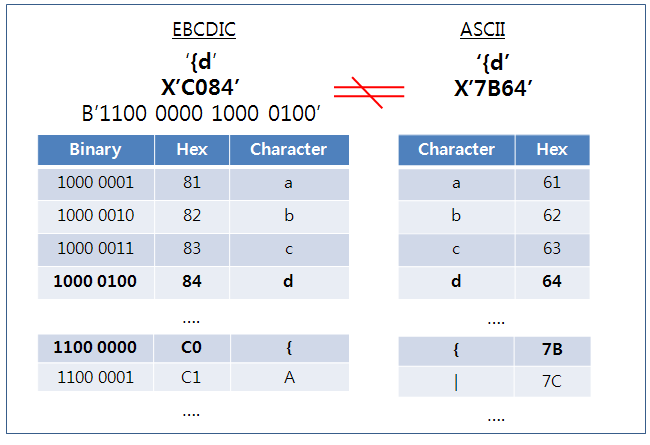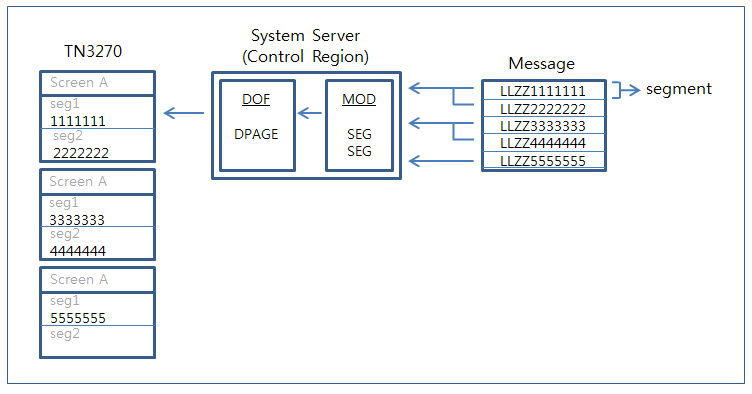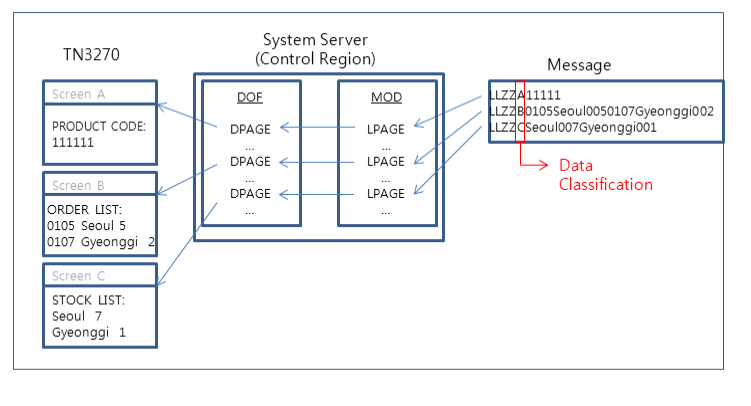MFS Function
This chapter describes main functions of MFS.
1. Dynamic Field Property Change
The function dynamically changes the regular properties and extended properties of a field that is displayed on a screen. If a user application adds property values (that will be used to change the current values) in front of the field before sending it, MFS interprets it and sends it to a terminal after changing the DFLD property which is defined in a map.
1.1. Regular Property Change
In a regular property change, cursor position, field protection, number/character field, bright adjustment, hide, and MDT configuration, can be set. To use the function, set "ATTR=YES" in the MFLD statement, and define LTH for property data as 2 bytes longer than the actual data.
The property data bit structure is as follows:

| Byte | Bit | Description |
|---|---|---|
0 |
0-1 |
Moves the cursor to the current field.
|
2-7 |
Fixed to 0. |
|
1 |
0 |
Fixed to 1. |
1 |
Sets how to change the property.
|
|
2 |
Sets whether to protect the field.
|
|
3 |
Sets number/character field.
|
|
4-5 |
Sets the brightness
|
|
6 |
Sets the light pen field. (not supported) |
|
7 |
Sets MDT.
|
1.2. Extended Property Change
Extended property can change highlighting, color, and outline. To use the function, set MFLD statement to ATTR=(,nn). 2 bytes space is needed per property, that will be changed, so define LTH to the value which adds nn*2 to the actual data length. The property data consists of ATTR Type (1 byte) + ATTR Value (1 byte).
The following describes data.
-
Highlighting, Color
Type Value Description C1 (Highlighting)
X'00'
Default
X’F1'
HBLINK
X’F2'
HREV
X’F4'
HUL
C2(Color)
X'00'
Default
X’F1'
BLUE
X’F2'
RED
X’F3'
PINK
X’F4'
GREEN
X’F5'
TURQ
X’F6'
YELLOW
X’F7'
NEUTRAL
-
Outline
Type Bit Description 03 (Outline replacement) 04 (Outline addition)
0-3
Fixed to 0
4
Left line
5
Over line
6
Right line
7
Under line
X'00'
Default
1.3. Example
The following describes MFS map and COBOL program example that dynamically changes a regular property and two extended properties of a CODE field. The CODE field is defined as an unprotected field. But it was set to X’C0E8' in the COBOL program, so in the protected field, where the cursor is located, the character color is Turquoise and the borderline is displayed at top and bottom.
<TEST001.TXT>
*********************************************************************
TEST001 FMT
DEV TYPE=(3270,2), X
FEAT=IGNORE, X
DSCA=X'00A0'
...
CODE DFLD POS=(7,4), X
LTH=10, X
ATTR=(NOPROT,ALPHA,NORM,MOD)
...
FMTEND
*********************************************************************
TEST001I MSG TYPE=INPUT, X
SOR=(TEST001,IGNORE), X
NXT=TEST001O
SEG
MFLD 'TESTMPP1', X
LTH=8
...
MSGEND
*********************************************************************
TEST001O MSG TYPE=OUTPUT, X
SOR=(TEST001,IGNORE), X
NXT=TEST001I
SEG
...
MFLD CODE, X
LTH=16,ATTR=(YES,2)
...
MSGEND
**********************************************************************
<TESTMPP1.cob>
ID DIVISION.
PROGRAM-ID. TESTMPP1.
AUTHOR. TMAXSOFT.
DATA DIVISION.
WORKING-STORAGE SECTION.
...
01 OUTPUT-MESSAGE-IO-AREA.
05 OM-LL PIC S9(3) COMP.
05 OM-Z1-Z2 PIC S9(3) COMP VALUE ZERO.
05 OM-MSG-DATA.
...
10 OM-OUT1.
15 OM-OUTFLD-DYNA-ATTR.
25 OM-OUTFLD-ATTR PIC X(2).
25 OM-OUTFLD-EATTR1 PIC X(2).
25 OM-OUTFLD-EATTR2 PIC X(2).
15 OM-OUTFLD-DATA PIC X(10).
...
PROCEDURE DIVISION.
...
* CURSOR ON, ATTR OVERRIDE, PROT, HIGH
MOVE X'C0E0' TO OM-OUTFLD-ATTR.
* COLOR: TURQ
MOVE X'C2F5' TO OM-OUTFLD-EATTR1.
* OUTLINE: OVER,RIGHT,UNDER
MOVE X'0305' TO OM-DAMFLD-EATTR2.
...
1.4. Cautions
OpenFrame is based on an ASCII environment. For property data, the character itself is not significant. Each bit has a specific meaning so the Hexa values defined on a EBCDIC environment will be used as they are. If property data is described as literal in a user application, it should be converted to EBCDIC Hexa values to enable normal operation.
For example, if the cursor is located in a field, and the dynamic property change data, which adds the NODISP property, is described in EBCDIC, it will be interpreted differently, as follows:
-
Before change
... * CURSOR ON, NODISP MOVE '{d' TO OM-OUTFLD-ATTR. ... Comparison of EBCDIC and ASCII Values of the Character '{d''
Comparison of EBCDIC and ASCII Values of the Character '{d'' -
After change
... * CURSOR ON, NODISP MOVE X'C084' TO OM-OUTFLD-ATTR. ...
2. Paging
One message can consist of multiple segments, and this data can consist of one format or multiple formats. MFS supports both two cases. Browsing a single format message is called physical paging, and browsing multi-format message is called logical paging. In a single message, both logical and physical paging can be used.
This section describes each data structure and how to write a multi-format MFS definition statement.
2.1. Single Format
A regular MOD has one SEG statement, but defining multiple SEG statements is possible.
If MOD consists of two SEG statements, and the data sent from an application has 5 segments, one message will be displayed by being divided into three as shown in the following figure. To see the next data from the first screen (displays the first and second segments), press the PA1 button. For more information, refer to PA1, PA2 Functions description.

2.2. Multi-Format
Depending on an application, a single message may have various formats of data.
In a single MFS definition statement, each screen should be defined. MOD defines the condition to distinguish data and corresponding LPAGE statement. DOF defines screen which will be displayed in each case by DPAGE statements. MFS displays an appropriate screen depending on COND of data and LPAGE statement. When MFS investigates which data belongs to which LPAGE, if there are no met conditions, the last LPAGE will be selected. MFLD which is used in the condition investigation, must be located in the first SEG.

<TEST002.TXT>
*********************************************************************
TEST002 FMT
DEV TYPE=(3270,2), X
FEAT=IGNORE, X
DSCA=X'00A0'
...
PAGEA DPAGE CURSOR=((3,2))
DFLD 'PRODUCT CODE:', X
POS=(2,2), X
ATTR=(PROT,ALPHA,HI,NOMOD)
CODE DFLD POS=(3,2), X
LTH=6, X
ATTR=(NOPROT,NUM,NORM,MOD)
...
PAGEB DPAGE CURSOR=((1,2))
DFLD 'ORDER LIST:', X
POS=(2,2), X
ATTR=(PROT,ALPHA,HI,NOMOD)
ODATE1 DFLD POS=(3,2), X
LTH=4, X
ATTR=(PROT,ALPHA,HI,NOMOD)
OLOCA1 DFLD POS=(3,7), X
LTH=4, X
ATTR=(PROT,ALPHA,HI,NOMOD)
ONUMB1 DFLD POS=(3,12), X
LTH=3, X
ATTR=(PROT,ALPHA,HI,NOMOD)
...
PAGEC DPAGE CURSOR=((1,2))
DFLD 'STOCK LIST:', X
POS=(2,2), X
ATTR=(PROT,ALPHA,HI,NOMOD)
SLOCA1 DFLD POS=(3,2), X
LTH=4, X
ATTR=(PROT,ALPHA,HI,NOMOD)
SNUMB1 DFLD POS=(3,7), X
LTH=3, X
ATTR=(PROT,ALPHA,HI,NOMOD)
...
FMTEND
*********************************************************************
TEST002I MSG TYPE=INPUT, X
SOR=(TEST002,IGNORE), X
NXT=TEST002O
SEG
MFLD 'TESTMPP2',LTH=8
...
MSGEND
*********************************************************************
TEST002O MSG TYPE=OUTPUT, X
SOR=(TEST002,IGNORE), X
NXT=TEST002I
PRODLP LPAGE SOR=PAGEA,COND=(LPAGEID,=,'A')
SEG
LPAGEID MFLD LTH=1
MFLD CODE,LTH=6
...
ORDRLP LPAGE SOR=PAGEB,COND=(LPAGEID,=,'B')
SEG
LPAGEID MFLD LTH=1
MFLD ODATE1,LTH=4
MFLD OLOCA1,LTH=4
MFLD ONUMB1,LTH=3,JUST=R
...
STOCLP LPAGE SOR=PAGEC,COND=(LPAGEID,=,'C')
SEG
LPAGEID MFLD LTH=1
MFLD SLOCA1,LTH=4
MFLD SNUMB1,LTH=3,JUST=R
...
MSGEND
**********************************************************************
2.3. PA1, PA2 Functions
If a message cannot be displayed at once, it will be displayed on multiple pages. To go to the next page, the PA1 button is used. If the page being displayed is the last page of the message and the next message is in a queue, pressing PA1 will display the first page of the next message. If there are no messages in a queue, the current page will remain on the terminal (no change).
The PA2 button deletes the currently open message from the queue and displays the first page of the next message. If there are no messages in a queue, and if PA2 is pressed, the current message will be dequeued and the current page will remain on the terminal (no change).

2.4. Use of the Z2 Field
If a message is organized according to the number of segments defined in MOD, the Z2 field of output message can be ignored. But to end the page without filling out all the segments defined in an application, the Z2 field of the next segment should be set to X'40' to start a new logical page and to notify it to MFS.

2.5. OLP (Operator Logical Paging) Function
If 'PAGE=YES' is set in an MSG statement when defining a multi-format map, the function that goes to a certain logical page in a message can be used. To use the function, place the following values at the beginning of an input value.
| OLP | Description |
|---|---|
=n, =nn, =nnn |
Move to the page corresponding to 'n' |
=+n, =+nn, =+nnn |
Move to the page that is 'n' steps behind the current page. |
=-n, =-nn, =-nnn |
Move to the page that is 'n' steps ahead of the current page. |
|
'n' is a digit. |